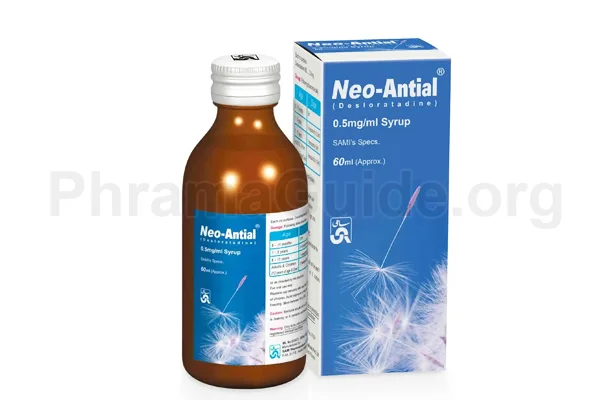Neo-Antial syrup is an antihistamine medication primarily used to relieve allergy symptoms in children. It provides relief from symptoms such as sneezing, runny nose, itchy or watery eyes, and itching of the nose or throat. The following are some common uses and indications of Neo-Antial Syrup:
- Allergic Rhinitis: Neo-Antial syrup is commonly used to manage allergic rhinitis, commonly known as hay fever, in children. It helps alleviate symptoms caused by allergens such as pollen, dust mites, pet dander, or mold spores. This includes sneezing, nasal congestion, itching, and a runny or stuffy nose.
- Seasonal Allergies: Seasonal allergies, which occur during specific times of the year, can significantly impact a child’s quality of life. Neo-Antial syrup is often used to provide relief from symptoms related to seasonal allergic reactions triggered by pollen, grass, or certain plants.
- Perennial Allergies: Perennial allergies are ongoing allergies that persist year-round due to triggers like dust mites, pet dander, or mold. Neo-antial syrup can help manage the symptoms associated with perennial allergic rhinitis, providing relief from chronic sneezing, nasal congestion, and itching.
- Urticaria (Hives): Neo-Antial syrup is effective in relieving symptoms of acute and chronic urticaria in children. Urticaria, commonly known as hives, manifests as itchy, raised, red, or white bumps on the skin. Neo-antial helps reduce itching and the appearance of hives, providing relief for the child.
Off-label Uses of Neo-Antial Syrup
- Chronic Idiopathic Urticaria (CIU) in Children: Neo-Antial syrup may be used off-label to manage chronic idiopathic urticaria (CIU) in children. CIU refers to hives or welts that appear without any identifiable cause and last for more than six weeks. Neo-Antial can help relieve itching and reduce the frequency and severity of hives.
- Eczema (Atopic Dermatitis) Symptom Relief: Neo-Antial syrup may be used off-label to help alleviate symptoms associated with eczema, also known as atopic dermatitis, in children. While it does not treat the underlying cause of eczema, it can provide some relief from itching, which is a common symptom of the condition.
- Dermatographism: Dermatographism, also known as “skin writing,” is a condition in which the skin becomes raised and red when scratched or rubbed. Neo-Antial syrup may be used off-label to manage the symptoms of dermatographism, including the itching and hives that can occur in response to pressure or friction on the skin.
- Mastocytosis: Mastocytosis is a rare condition characterized by an excessive number of mast cells in the body. It can lead to symptoms such as skin rashes, itching, flushing, and gastrointestinal issues. Neo-Antial syrup may be used off-label to help alleviate symptoms associated with mastocytosis, particularly itching, and hives.

What is Neo-Antial?
Neo-Antial Syrup is one of the leading brands of Desloratadine in oral liquid form, manufactured and marketed by Sami Pharmaceuticals (Pvt) Ltd, Pakistan.
Neo-Antial Alternatives : Desloratadine Other Brands
The following are some alternative brands of Neo-Antial Syrup and their manufacturers.
Desora : Continental Pharmaceuticals, Pakistan.
Deslor : Everest Pharmaceuticals, Pakistan.
Jardin-D : High-Q Pharmaceuticals (Pvt) Ltd, Pakistan.
Deslavid : Abbott Laboratories, Pakistan.
Larinex : Getz Pharmaceuticals (Pvt) Ltd, Pakistan.
Deslet : Efroz Pharmaceuticals (Pvt) Ltd, Pakistan.
Antimin-D : Shaigan Pharmaceuticals (Pvt) Ltd, Pakistan.
Destina : Hilton Pharmaceuticals (Pvt) Ltd, Pakistan.
Desgen : Envoy Pharmaceuticals (Pvt) Ltd, Pakistan.
Xylor : Atco Laboratories (Pvt) Ltd, Pakistan.
Neo-Antial : Available Formulations and Strengths
Presently, Neo-Antial is available in Syrup and Tablet forms.
Neo-Antial Syrup : 0.5mg/ml (2.5mg/5ml) strength.
Neo-Antial Tablet : 5mg strength.
Who Should Not Use Neo-Antial?
Neo-Antial syrup, like any medication, has certain contraindications—specific situations or conditions in which the use of neo-Antial is not recommended due to potential risks or adverse effects.
Hypersensitivity: Neo-Antial syrup is contraindicated in individuals who have a known hypersensitivity or allergic reaction to Neo-Antial or any of its components. Allergic reactions to Neo-Antial can range from mild to severe and may include symptoms such as rash, itching, swelling, difficulty breathing, or anaphylaxis. If you have experienced an allergic reaction to Neo-Antial or any antihistamines in the past, it is important to inform your healthcare professional.
Severe Liver Impairment: Neo-Antial syrup is primarily metabolized in the liver. Therefore, it is contraindicated in individuals with severe liver impairment or active liver disease. The use of Neo-Antial in such cases may exacerbate liver dysfunction or interfere with the clearance of the medication from the body.
Pregnancy and Breastfeeding: The safety of Neo-Antial syrup during pregnancy and breastfeeding has not been adequately studied. As a precaution, it is generally recommended to avoid using Neo-Antial during pregnancy unless the potential benefits outweigh the risks. It is also not recommended to use Neo-Antial while breastfeeding due to the potential for the medication to be excreted in breast milk.
Children under 6 months of age: Neo-Antial syrup is not recommended for use in children under 6 months of age, as the safety and effectiveness of the medication in this age group have not been established.
Recommended Daily Dosage of Neo-Antial Syrup
Neo-Antial Syrup Dose for Allergic Rhinitis:
- For Adults and Children (12 years and older): 5 mg (10 ml of syrup) once daily.
- For Children (6 to 11 years): 2.5 mg (10 ml of syrup) once daily.
- For Children (1 to 5 years): 1.25 mg (Half Teaspoon) once daily.
Neo-Antial Syrup Dose for Chronic Idiopathic Urticaria:
- For Adults and Children (12 years and older): 5 mg (10 ml of syrup) once daily.
- For Children (6 to 11 years): 2.5 mg (10 ml of syrup) once daily.
- For Children (1 to 5 years): 1.25 mg (Half Teaspoon) once daily.
How Neo-Antial Works?
Neo-Antial is a second-generation antihistamine that works by blocking the effects of histamine, a natural substance released by the body during an allergic reaction. Its mode of action involves binding to specific histamine receptors and preventing histamine from binding to these receptors.

Leave A Comment